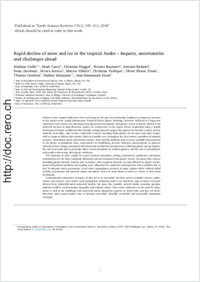Rapid decline of snow and ice in the tropical Andes – Impacts, uncertainties and challenges ahead
- Vuille, Mathias Dept. of Atmospheric & Environmental Sciences, Univ. at Albany, Albany, NY, USA
- Carey, Mark Robert D. Clark Honors College, University of Oregon, Eugene, OR, USA
- Huggel, Christian Dept. of Geography, Univ. of Zurich, Switzerland
- Buytaert, Wouter Dept. of Civil and Environmental Engineering, Imperial College London, UK
- Rabatel, Antoine Univ. Grenoble Alpes, CNRS, IRD, Institut des Géosciences de l'Environnement (IGE), Grenoble, France
- Jacobsen, Dean Freshwater Biological Laboratory, Dept. of Biology, University of Copenhagen, Denmark
- Soruco, Alvaro Instituto de Investigaciones Geológicas y del Medio Ambiente, Universidad Mayor de San Andres, La Paz, Bolivia
- Villacis, Marcos Depto. de Ingenieria Civil y Ambiental, Escuela Politecnica Nacional, Quito, Ecuador
- Yarleque, Christian Dept. of Atmospheric & Environmental Sciences, Univ. at Albany, Albany, NY, USA
- Timm, Oliver Elison Dept. of Atmospheric & Environmental Sciences, Univ. at Albany, Albany, NY, USA
- Condom, Thomas Univ. Grenoble Alpes, CNRS, IRD, Institut des Géosciences de l'Environnement (IGE), Grenoble, France
- Salzmann, Nadine Dept. of Geography, Univ. of Zurich, Switzerland - Dept. of Geosciences, Univ. of Fribourg, Switzerland
- Sicart, Jean-Emmanuel Univ. Grenoble Alpes, CNRS, IRD, Institut des Géosciences de l'Environnement (IGE), Grenoble, France
-
01.01.2018
Published in:
- Earth-Science Reviews. - 2018, vol. 176, p. 195–213
English
Glaciers in the tropical Andes have been retreating for the past several decades, leading to a temporary increase in dry season water supply downstream. Projected future glacier shrinkage, however, will lead to a long-term reduction in dry season river discharge from glacierized catchments. This glacier retreat is closely related to the observed increase in high-elevation, surface air temperature in the region. Future projections using a simple freezing level height- equilibrium-line altitude scaling approach suggest that glaciers in the inner tropics, such as Antizana in Ecuador, may be most vulnerable to future warming while glaciers in the more arid outer tropics, such as Zongo in Bolivia, may persist, albeit in a smaller size, throughout the 21st century regardless of emission scenario. Nonetheless many uncertainties persist, most notably problems with accurate snowfall measurements in the glacier accumulation zone, uncertainties in establishing accurate thickness measurements on glaciers, unknown future changes associated with local-scale circulation and cloud cover affecting glacier energy balance, the role of aerosols and in particular black carbon deposition on Andean glaciers, and the role of groundwater and aquifers interacting with glacier meltwater.The reduction in water supply for export-oriented agriculture, mining, hydropower production and human consumption are the most commonly discussed concerns associated with glacier retreat, but many other aspects including glacial hazards, tourism and recreation, and ecosystem integrity are also affected by glacier retreat. Social and political problems surrounding water allocation for subsistence farming have led to conflicts due to lack of adequate water governance. Local water management practices in many regions reflect cultural belief systems, perceptions and spiritual values and glacier retreat in some places is seen as a threat to these local livelihoods.Comprehensive adaptation strategies, if they are to be successful, therefore need to consider science, policy, culture and practice, and involve local populations. Planning needs to be based not only on future scenarios derived from physically-based numerical models, but must also consider societal needs, economic agendas, political conflicts, socioeconomic inequality and cultural values. This review elaborates on the need for adaptation as well as the challenges and constraints many adaptation projects are faced with, and lays out future directions where opportunities exist to develop successful, culturally acceptable and sustainable adaptation strategies.
- Faculty
- Faculté des sciences et de médecine
- Department
- Département de Géosciences
- Language
-
- English
- Classification
- Hydrology
- License
-
License undefined
- Identifiers
-
- RERO DOC 309005
- DOI 10.1016/j.earscirev.2017.09.019
- Persistent URL
- https://folia.unifr.ch/unifr/documents/306546
Statistics
Document views: 183
File downloads:
- pdf: 1290
